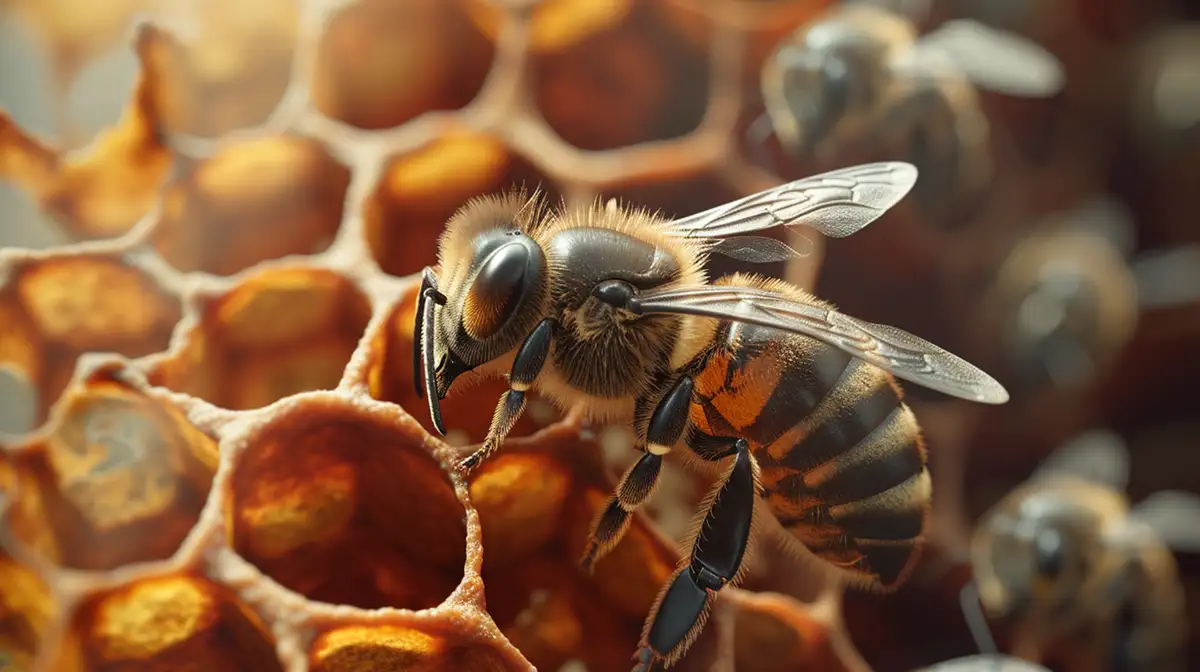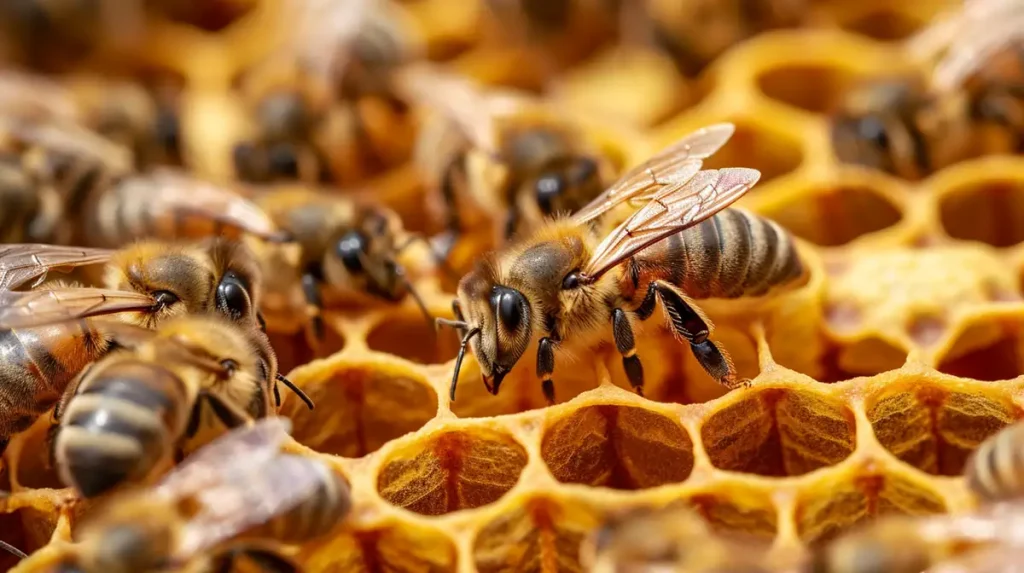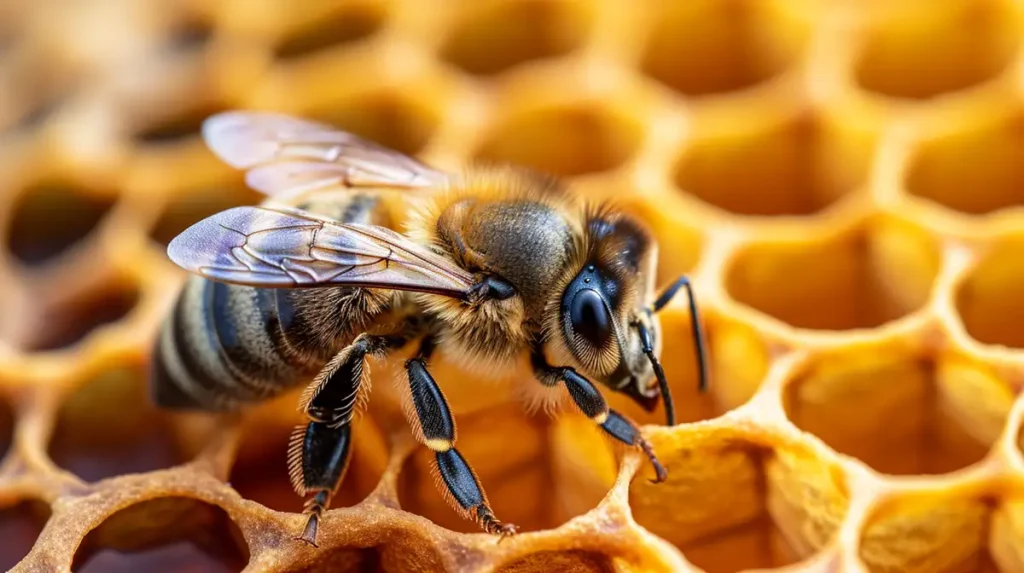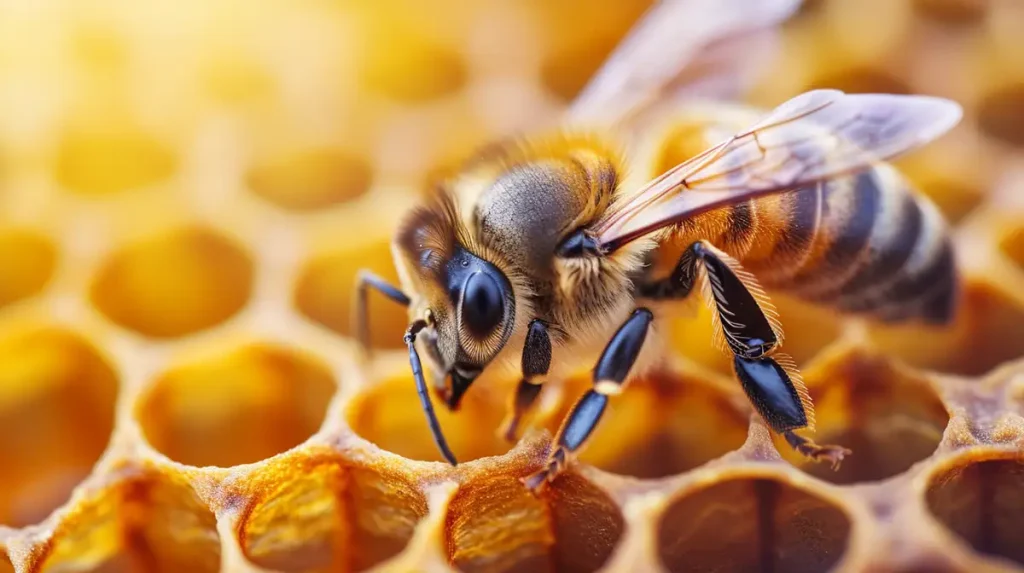Table of Contents
A bee becomes a queen through the exclusive feeding of royal jelly to selected larvae by worker bees. This diet triggers the development of the larvae into queens with fully functional ovaries, distinguishing them from workers. The first larva to mature typically becomes the new queen, essential for the colony’s reproduction and survival.
In the below paragraphs, we will take a more detailed look at this topic.
In a colony of honeybees, there is only ever one queen bee. She is responsible for laying eggs and maintaining order within the hive by releasing calming pheromones. Without the queen, the colony would be in disarray and the other bees would begin to die off one by one. Without the queen to lay more eggs, the colony would not survive. So how does a bee become a queen? Can any bee become a queen?
Key Takeaways
- Queen bee selection occurs when the current queen’s productivity declines, or she is no longer present due to death or swarming.
- Royal jelly, a highly nutritious substance secreted by nurse bees, is critical for the development of a queen bee.
- Worker bees choose several larvae less than three days old and move them into specialized queen cups, feeding them royal jelly throughout their development.
- Queen bee larvae grow larger and develop reproductive organs, enabling them to lay eggs.
- The first queen to emerge eliminates rivals by stinging them in their cells, or battles to the death if two emerge simultaneously.
- The new queen embarks on a mating flight, mating with multiple drones before returning to the hive to lay eggs.
- Factors that influence queen bee development include royal jelly availability, queen pheromones, colony size and population, and environmental conditions.
- Worker bees contribute to queen bee birth by feeding her royal jelly, tending to her cell, and choosing the next queen through swarm or supersedure.
- A queen bee becomes “pregnant” by taking a mating flight, mating with drones in Drone Congregation Areas, storing sperm in her spermatheca, and selectively fertilizing eggs as she lays them.
Here is a detailed table outlining various factors that determine the development of a queen bee:
| Factor | Description | Impact on Development |
|---|---|---|
| Feeding | Larvae selected to become queens are exclusively fed royal jelly, a protein-rich secretion from the glands of worker bees. | Royal jelly induces the development of fully functional ovaries and other queen characteristics, unlike the honey and pollen diet of worker bees. |
| Cell Size | Queen cells are larger than worker bee cells and are built vertically. | The size and orientation allow for the proper growth and development of the queen larva. |
| Age of Larvae | Only larvae less than three days old are selected to be reared as queens. | Ensures that only the most suitable, young larvae undergo the transformation into a queen, optimizing their developmental potential. |
| Genetics | The genetic makeup of the larvae plays a crucial role in its potential to develop into a healthy queen. | Certain genetic traits may predispose larvae to be more viable as queens, affecting their longevity, fertility, and ability to produce pheromones. |
| Quantity of Royal Jelly | The quantity of royal jelly fed to the larvae is significantly higher for those destined to become queens. | Provides the necessary nutritional support for the extensive development required to become a fertile queen. |
| Colony Needs | The colony’s need for a new queen, triggered by the absence, aging, or impending division of the colony, determines the initiation of queen rearing. | Drives the decision to rear new queens, influencing the timing and number of queens developed. |
| Environmental Conditions | Temperature, humidity, and overall health of the colony can affect queen development. | Optimal conditions support the healthy growth of queen larvae, while adverse conditions may hinder their development. |
| Pheromonal Signals | The presence or absence of queen pheromones influences the initiation of queen rearing. | Absence of queen pheromones signals the colony to start rearing a new queen, while their presence inhibits queen rearing. |
This table encapsulates the multifaceted process behind the development of a queen bee, highlighting the interplay of dietary, genetic, environmental, and social factors that determine her emergence and success within the colony.
How Is A Queen Bee Chosen Within A Hive?
The selection of a queen bee within a hive is a fascinating and intricate process. It begins when the current queen’s productivity declines or she is no longer present in the hive due to death or swarming. Worker bees then take action to ensure the colony’s survival by choosing and raising a new queen.
The Role of Royal Jelly
The key to producing a queen bee lies in the specialized food called royal jelly. Royal jelly is a highly nutritious substance secreted by nurse bees that is fed exclusively to larvae designated to become queen bees. This substance is rich in proteins, vitamins, and lipids, which play a critical role in the development of a queen.
The Selection Process
When the need for a new queen arises, worker bees will choose several young larvae that are less than three days old. These chosen larvae are then moved into specialized queen cups, which are larger than the average worker cell. The nurse bees feed these larvae copious amounts of royal jelly throughout their developmental stage, which lasts about 5-6 days.
As a result of this nutrient-rich diet, the larvae that are destined to become queens develop differently than worker bees. They grow larger, their reproductive organs fully mature, and they develop the ability to lay eggs.
The Emergence of a New Queen
Once the queen larvae have fully developed, they pupate and transform into adult queen bees. The first queen to emerge from her cell will seek out and eliminate her rival queens by stinging them in their cells. This ensures that she will be the only queen in the hive. In some cases, if two queens emerge at the same time they may engage in a battle to the death, with the victor claiming the role of the hive’s queen.
After the new queen establishes her dominance, she will embark on a mating flight to mate with multiple drones from other hives. Once she has successfully mated and stored enough sperm, she will return to the hive and begin laying eggs to repopulate the colony. The new queen bee will then reign over her colony, with her subjects working tirelessly to support her and ensure the hive’s continued success.
What Factors Determine The Development Of A Queen Bee?
The development of a queen bee within a honeybee colony is a fascinating process that is influenced by several key factors. These factors work together to ensure the survival and prosperity of the colony.
1. Availability of Royal Jelly
The primary factor that determines the development of a queen bee is the availability of royal jelly. All larvae, including potential queen bees, are initially fed royal jelly for the first few days of their lives. However, only the selected larvae destined to become queens continue to receive royal jelly exclusively throughout their development while the others are switched to a diet of honey and pollen. The continued nourishment with royal jelly allows the chosen larvae to fully develop into queens.
- Carter, Anthony (Author)
- English (Publication Language)
- 194 Pages - 02/28/2024 (Publication Date) - Independently published (Publisher)
2. The Presence of Queen Pheromones
Queen pheromones play a crucial role in the colony’s dynamics. The current queen bee emits specific pheromones that suppress the development of new queens. If the queen is old, weak, or has died, her pheromone levels decrease. This signals the colony that it’s time to raise a new queen. In this case, worker bees will begin feeding select larvae with royal jelly, triggering their development into queen bees.
3. Colony Size and Population
The size and population of a colony can also influence the development of a queen bee. In larger colonies, there is a higher likelihood that swarming (a natural reproductive process where a portion of the colony leaves to establish a new hive) will occur. Prior to swarming, the colony will start raising new queen bees, ensuring that the remaining bees have a queen to take over after the swarm has left.
4. Environmental Conditions
Environmental conditions such as temperature, humidity, and the availability of food can impact the development of a queen bee. Optimal conditions are necessary for the healthy growth and development of larvae. If the colony is experiencing stress from unfavorable conditions, they may be less likely to invest in the development of a new queen bee.

How Do Worker Bees Contribute To The Birth Of A Queen Bee?
Worker bees play a crucial role in the birth of a queen bee. They are responsible for feeding and nurturing the queen larva, which ensures its proper development into a healthy and strong queen. The process begins when the current queen lays fertilized eggs in specially constructed, larger cells within the hive. These cells, known as queen cups, are where the future queen bee will develop.
Royal Jelly: The Secret Ingredient
The key factor that differentiates a queen bee from her worker siblings is her diet. Worker bees have specialized glands called hypopharyngeal glands, which produce a substance called royal jelly (discussed above). This nutritious, protein-rich substance is the exclusive food for queen larvae. In contrast, worker bee larvae only receive royal jelly for the first few days of their lives before they are switched to a diet of honey and pollen, also known as bee bread.
Tending to the Queen Larva
In addition to providing the queen larva with royal jelly, worker bees also take care of other essential tasks to ensure the successful development of the new queen. They constantly clean and maintain the queen cell, regulate temperature and humidity within the hive, and even remove waste produced by the developing larva. These tasks are vital to the overall health and well-being of the future queen bee.
Swarm or Supersedure: Choosing the Next Queen
Worker bees also play a role in choosing the next queen through a process called swarm or supersedure. In the case of swarming, the old queen leaves the hive with a portion of the worker bees to establish a new colony. The remaining worker bees then raise a new queen to take her place. In a supersedure, the workers will replace an aging or failing queen by raising a new queen within the same hive. In both cases, the worker bees feed and nurture the queen larvae, ultimately ensuring that the strongest and healthiest individual will emerge as the new queen.

How Does a Queen Bee Become ‘Pregnant’?
The process by which a queen bee becomes “pregnant” is a unique and extraordinary natural phenomenon. In the following section I will delve into the steps leading up to her fertilization and explain how she’s able to lay thousands of eggs throughout her lifetime.
Mating Flight
The journey begins when a virgin queen bee, usually around 5-15 days old, takes her nuptial or mating flight. This flight is a crucial event in her life as it’s the only time she’ll mate. During this flight, she’ll be pursued by hundreds or even thousands of male bees from various colonies. These drones are attracted to the queen’s pheromones, which signal her readiness to mate.
Drone Congregation Areas
Drones from different colonies gather in specific areas known as drone congregation areas (DCAs). It’s here that the queen bee will mate with multiple drones during her mating flight. These areas are typically located hundreds of feet above ground and can span several hundred meters.
Mating Process
While in the DCA, the queen bee will mate with 10-20 drones in mid-air. During this process, the male drone’s reproductive organ, the endophallus, is inserted into the queen’s sting chamber. Upon successful mating, the drone’s endophallus is ripped off, and he dies shortly afterward. The queen bee collects the sperm from each drone in a specialized organ called the spermatheca.
Fertilization and Egg Laying
Once the queen bee returns to her colony, she starts laying eggs. With the sperm stored in her spermatheca, she can selectively fertilize her eggs as needed. She can lay up to 2,000 eggs per day and will continue to do so for the duration of her life, which can last between 3 to 5 years. The fertilized eggs become female worker bees while the unfertilized eggs develop into male drones.

How Does a Bee Become a Queen – Conclusion
Queen bees can live for up to six years or longer but when they become old and die – or if they swarm – a new queen is needed. Sometimes a beekeeper will replace a queen, but this can result in the other bees rejecting and killing her.
Without a queen in the hive, the colony cannot survive. The bees know this so as soon as one queen dies or leaves, they will set about raising another one. They do this by placing newly hatched larvae in special queen cells. Until they have mated, these queens are known as virgin queens.
Once the virgin queens hatch, their first instinct is to kill their sister queens. They will fight to the death until only one remains. This remaining queen will also kill any other queens that have not hatched yet.
The new queen then takes a mating flight before taking over where the old queen left off – laying eggs. At her peak, she can lay up to 2,000 eggs in one day.
Last update on 2024-04-17 / Affiliate links / Images from Amazon Product Advertising API


